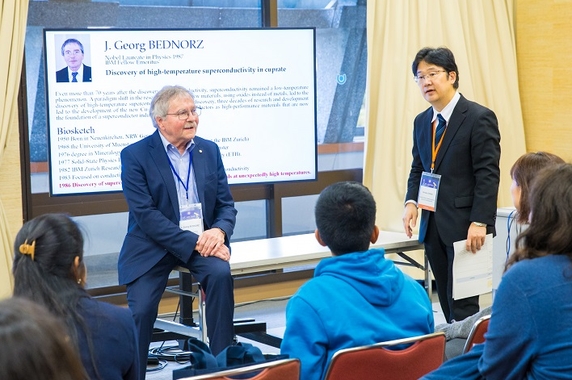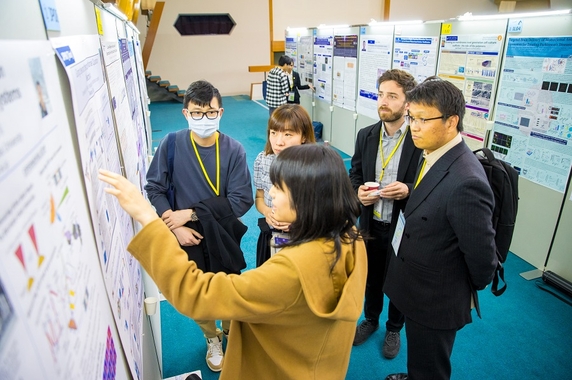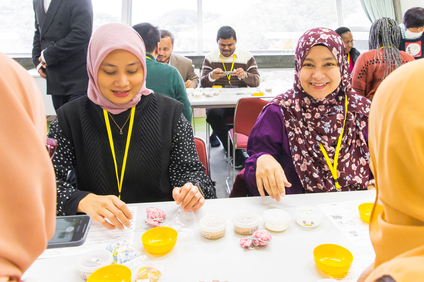HOPE Meetings with Nobel Laureates
15th HOPE Meeting
Report of the 15th HOPE Meeting
Date: Monday, 26 February through Friday, 1 March 2024
Venue: Kyoto International Conference Center (Kyoto-city, Kyoto, Japan)
Subject Fields: Physics, Chemistry, Physiology/Medicine and Related Fields
Organizer: Japan Society for the Promotion of Science (JSPS)
Venue: Kyoto International Conference Center (Kyoto-city, Kyoto, Japan)
Subject Fields: Physics, Chemistry, Physiology/Medicine and Related Fields
Organizer: Japan Society for the Promotion of Science (JSPS)

The 15th HOPE Meeting was attended by 102 doctoral students and young researchers from 20 participating Asia-Pacific and African countries and regions.
Japan, Australia, Bangladesh, China, India, Indonesia, Israel, Kenya, Korea, Malaysia, Nepal, New Zealand, Philippines, Senegal, Singapore, South Africa, Taiwan, Thailand, Turkey, Vietnam
Japan, Australia, Bangladesh, China, India, Indonesia, Israel, Kenya, Korea, Malaysia, Nepal, New Zealand, Philippines, Senegal, Singapore, South Africa, Taiwan, Thailand, Turkey, Vietnam
This was the first time for a HOPE Meeting to be held in Kyoto. Among the seven invited Nobel Laureates, three came to Japan from abroad and two came from within Japan to participate in person while two others joined the meeting online.
A moderator was appointed to work with each lecturer. These moderators served as a “bridge” between the participants and the eminent lecturers. The moderators also offered assistance to the participants in gaining an in-depth understanding of the lecturers’ presentations and in facilitating Q&A sessions and group discussions.
A moderator was appointed to work with each lecturer. These moderators served as a “bridge” between the participants and the eminent lecturers. The moderators also offered assistance to the participants in gaining an in-depth understanding of the lecturers’ presentations and in facilitating Q&A sessions and group discussions.
KAJITA Takaaki
Nobel Laureate in Physics 2015
J. Georg BEDNORZ
Nobel Laureate in Physics 1987
Morten MELDAL*
Nobel Laureate in Chemistry 2022
David W. C. MACMILLAN
Nobel Laureate in Chemistry 2021
Stefan W. HELL*
Nobel Laureate in Chemistry 2014
OHSUMI Yoshinori
Nobel Laureate in Physiology or Medicine 2016
Paul NURSE
Nobel Laureate in Physiology or Medicine 2001
*Lecturers who participated online
Listening to Words of Global Wisdom ―― Lectures by Nobel Laureates
During the sessions, each of the seven Nobel Laureates gave a one-hour lecture (45-minute talk and 15-minute Q&A). The young researchers took advantage of this opportunity to ask these global science leaders volleys of questions.

Dr. Nurse lecturing

Dr. Kajita lecturing

Dr. Hell lecturing (online)

Dr. MacMillan lecturing
Exchanging Words of Global Wisdom ―― Group Discussions
Five 45-minute group discussion slots were incorporated in the meeting agenda, each placing about 20 young researchers around one Nobel Laureate. All the participants took part in four of the group discussions, which provided a unique and precious opportunity for the young researchers to learn about the Nobel Laureates' personal histories in an intimate and friendly setting. They received words of inspiration and encouragement from the lecturers at this stage of their lives as budding scientists.

Dr. Bednorz in a group discussion

Dr. Meldal in a group discussion (online)

Dr. Ohsumi in a group discussion

Participants in a group discussion
The HOPE Meeting participants were assigned two tasks: one was to deliver a "poster presentation" in which they introduced their individual research activities; the other was to participate in a "team presentation," in which they worked together with teammates in a multicultural and multidisciplinary format to create team presentations, which were held on the last day of the meeting.
Introducing Research Activities ―― Flash Talks and Poster Sessions
Throughout the meeting, the participants' research posters were displayed in the hall, and poster sessions were held over a period of three days. On their assigned presentation day, the participants gave a "Flash Talk," a one-minute introduction to their research, after which they participated in a "Poster Session," where, standing in front of their own posters, they explained their research in more detail. Though it’s not easy to explain one's research to people of different specialties, the young researchers enthusiastically discussed their work with not only their peers but also with senior researchers, including Nobel Laureates and members of the Organizing Committee, all of whom listened intently and asked probing questions.
Poster awards were presented. The recipients were selected by the Organizing Committee via a collegial review process based on the results of voting by all the participants. The "Best Poster Award" was given to the six best poster presenters, and the "Chairperson's Award (HOPE Award)" was given to one of these winners.
Chairperson's Award (HOPE Award)
Gur LUBIN (Weizmann Institute of Science)
Best Poster Award
- Jiuyang XU (China-Japan Friendship Hospital)
- Diah Anggraini WULANDARI (National Research and Innovation Agency (BRIN) / Kyushu University)
- Gur LUBIN (Weizmann Institute of Science)
- Sopak SUPAKUL (Keio University)
- Izabela POREBSKA (Okinawa Institute of Science and Technology (OIST))
- Jesin JAMES (The University of Auckland)
Poster awards were presented. The recipients were selected by the Organizing Committee via a collegial review process based on the results of voting by all the participants. The "Best Poster Award" was given to the six best poster presenters, and the "Chairperson's Award (HOPE Award)" was given to one of these winners.
Chairperson's Award (HOPE Award)
Gur LUBIN (Weizmann Institute of Science)
Best Poster Award
- Jiuyang XU (China-Japan Friendship Hospital)
- Diah Anggraini WULANDARI (National Research and Innovation Agency (BRIN) / Kyushu University)
- Gur LUBIN (Weizmann Institute of Science)
- Sopak SUPAKUL (Keio University)
- Izabela POREBSKA (Okinawa Institute of Science and Technology (OIST))
- Jesin JAMES (The University of Auckland)

Poster Session

Dr. MacMillan at a Poster Session

Dr. Kajita at a Poster Session

Winners of the "Best Poster Presentation Award"
Creating Presentations with Peers ―― Team Presentations
The 102 participants were assigned by the secretariat to 11 teams, titled A to K. Within a limited timeframe, teammates of different cultural backgrounds and research fields worked together to create presentations on how they, as scientists, could contribute to solving common societal problems, such as achieving SDGs (Sustainable Development Goals). The presentations were delivered on the final day on the meeting. In the process of creating their presentations, the participants must have realized the words of Organizing Committee Chair Dr. KAJITA Takaaki spoken in his opening address: "Scientific research is advanced through collaboration among researchers who face common challenges and share interests regardless of country, region, gender, or specialty."
In the closing ceremony, two types of awards (Unique and Best) were presented to the two winning teams by Dr. KAJITA based on the results of voting by all the participants.
In the closing ceremony, two types of awards (Unique and Best) were presented to the two winning teams by Dr. KAJITA based on the results of voting by all the participants.

Participants working in teams on assignments

Team Presentation

Winner of the "Best Team Presentation Award" (Team A)

Winner of the "Unique Team Presentation Award" (Team K)
Learning Firsthand about Research in Japan ―― Research Facility Visits
To give the young researchers hailing from various countries and regions a feel for Japan’s cutting-edge research, the program provided time for visits to research facilities in Kyoto. Divided into three groups, the participants visited three of Japan's leading research institutions: Center for iPS Cell Research and Application, Kyoto University (CiRA), Institute for Integrated Cell-Material Sciences, Kyoto University (iCeMS), and Research Institute for Humanity and Nature (RIHN), where they received briefings from researchers and observed research facilities and laboratories.

Research Institute for Humanity and Nature (RIHN)

Institute for Integrated Cell-Material Sciences, Kyoto University (iCeMS)
In addition to these visits, members of RIKEN and the National Institute of Advanced Industrial Science and Technology (AIST) gave online presentations on their research facilities during a group discussion period. JSPS’s staff also introduced our Fellowship Programs for Overseas Researchers. Both described the pathways and support systems provided by their organizations for young researchers from other countries to pursue their research in Japan.
Opening Remarks by the Minister and Reception Party
The opening ceremony included a video address from the Minister of Education, Culture, Sports, Science and Technology.
A reception held for the participants and lecturers in the evening of the meeting’s first day was also attended by embassy officials from the participants' countries and “HOPE Fellows,” alumni who had attended previous HOPE Meetings.
A reception held for the participants and lecturers in the evening of the meeting’s first day was also attended by embassy officials from the participants' countries and “HOPE Fellows,” alumni who had attended previous HOPE Meetings.
Experiencing Japanese Culture ―― Concerts and Cultural Experiences
During the meeting, programs were also provided that gave the participants a chance to experience Japanese culture.
On February 26, a concert featuring Japanese drums was held during the reception party.
On February 29, a Japanese cultural experience program was held. After viewing a performance of Gagaku (ancient Japanese court music) instruments, the participants divided into three programs based on their choices: zazen (seated Zen meditation), tea ceremony, and making nioi-bukuro (scent sachet), where they experienced traditional Japanese culture through hands-on activities.
An excursion to the Rokuonji temple (Kinkaku), Ninnaji temple, and Kitano-tenmangu shrine was also held on the last day.
On February 26, a concert featuring Japanese drums was held during the reception party.
On February 29, a Japanese cultural experience program was held. After viewing a performance of Gagaku (ancient Japanese court music) instruments, the participants divided into three programs based on their choices: zazen (seated Zen meditation), tea ceremony, and making nioi-bukuro (scent sachet), where they experienced traditional Japanese culture through hands-on activities.
An excursion to the Rokuonji temple (Kinkaku), Ninnaji temple, and Kitano-tenmangu shrine was also held on the last day.

Japanese drum concert

Japanese culture experience(seated Zen meditation)

Japanese culture experience(nioi-bukuro)

Excursion (Rokuonji)
